Life in Space
During their stay on the International Space Station (ISS) astronauts have to continue living and working in an environment that is very different to that here on Earth. They still need to keep clean, go to the bathroom, eat and drink and keep fit and healthy. The conditions of weightlessness on the ISS mean they need to adapt these activities.
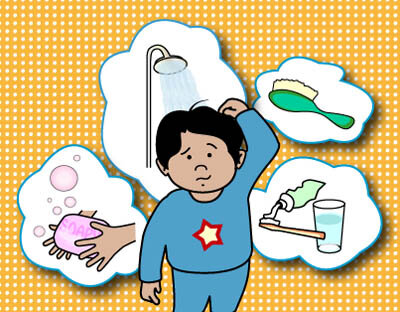
The ISS is orbiting 400 kilometres from Earth and everything needs to be taken there from Earth. This means that the astronauts have to conserve resources such as water and food and waste needs to be kept to a minimum.
In this series of video clips, ESA astronaut Frank De Winne and some of his fellow crew members, explain how they live on board the International Space Station. Attached to these video clips (filmed during the OasISS mission) are some short lessons that educators can use in the classroom.
Personal Hygiene
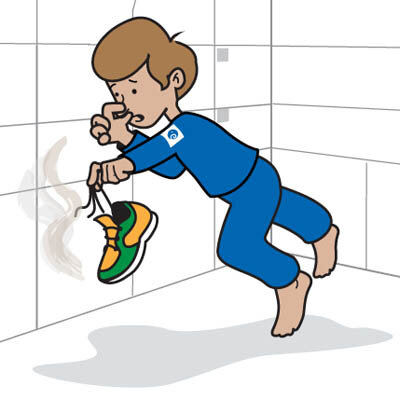
Whether you are at home, school or vacation one thing you will need to do everyday is to look after your personal hygiene. What does this mean? Well, washing yourself, brushing your teeth, using the toilet and even putting on reasonably fresh, clean clothes.
Even on the International Space Station (the ISS), astronauts need to carry out personal hygiene. In such a small space that you have to share with up to 13 people at times, things can become very unpleasant if someone is not taking care of business! Lets start with the hygiene basics:
Teeth
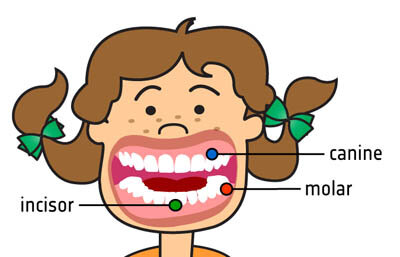
Why do we have teeth and what do they do? How to take care of our teeth? Why is this important? Write down all the reasons why you think teeth are useful.
Take a mirror and have a good look at your teeth. How many different kinds of teeth can you see and feel? Sharp teeth in the front of your mouth are called incisors. Pointed teeth next to them are called canines and the wider teeth with bumps are called molars.
Count how many teeth you have. Draw a picture of your teeth as you can see from the mirror.
Experiment: effect of fizzy drinks on teeth
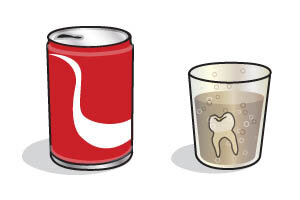
If you have a tooth that has fallen out – like a milk tooth – place it in a glass with cola or another fizzy drink you normally would drink. Keep looking at it everyday for a week. What happens to it? Make a picture of the tooth before and after it has been in the drink. Do you know why it changes?
Can you think why it is important to limit how much fizzy drinks you consume? What is in the ‘fizz’ of the drink that spoils the tooth? Why do we use toothpaste? How often do you need to brush your teeth with toothpaste?
Answers:
There are about 20-25 teeth in the mouth of most young children.
Brushing teeth is important to prevent tooth decay and bad breath. If you stop brushing teeth your mouth will smell and your teeth will begin to hurt and develop cavities.
Fizzy drinks are acidic which can damage the enamel of the tooth. Brushing your teeth after meals with fluoride toothpaste can help prevent tooth decay and strengthen teeth. It also makes your mouth smell fresh! When you wake up in the morning, one of the first things you do is brush your teeth. Why do you need to do this?
When you eat, some of the sugar in the food stays in your mouth. Bacteria feed on this sugar and make acid. This acid dissolves the enamel of your tooth and can cause tooth decay (cavities) - this hurts (tooth ache)! You need to see a dentist regularly to check this does not happen. Everyone needs to keep their teeth healthy and clean - even astronauts in space - the dentist is very far away if they develop tooth ache!
In Space
Astronauts brush their teeth in the normal way as you do, but there is a difference! In the first video clip, look at how everything ‘floats’ around. This is because on the ISS there is no weight pulling things downwards like on earth.
The Space Station is orbiting the Earth so fast (28000 kilometres per hour) at the correct speed and direction; it does not fall down to Earth but keeps falling around the Earth. Because it is falling everything inside it is weightless. So everything floats! Even water and toothpaste.
The toothpaste astronauts use can be swallowed after brushing (edible toothpaste) and the mouth is then cleaned with a wet wipe. The astronauts have to brush with their mouth as closed as possible to prevent the toothpaste floating out!
Going to the bathroom on the ISS
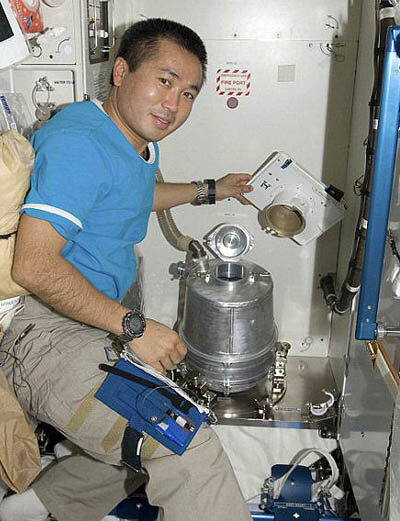
So if everything ‘floats’ in space, then how do you go to the toilet? There is a special toilet on the ISS (situated on the Russian module Zvezsda). There will be another one which will be situated on the American module – as the number of crew on the ISS will go up.
The astronauts have to strap themselves in to prevent floating off. Instead of a flush toilet there is a suction tube which carries the waste away in an air stream down a hole. The solid gets compressed and stored for disposal later. The urine is connected and later recycled. Certainly a strange way to go to the bathroom!
Eating and drinking on the ISS
As well as exercise, nutrition plays an important role in maintaining the health of the astronauts. Food is not just used for providing sufficient number of calories for working but meal times are important social occasions for people so far away from their families and friends.
The food is specially prepared because weightlessness requires adjustments to prevent the food from floating off a plate. Some types of food must also be eaten to counter the effects of adaptation to the space environment.
Astronauts get to choose which meals they would like so long as the nutritional values and calories are kept within the approved requirements: 2800 calories per day. The food trays are prepared on the ground for each astronaut and delivered to the ISS before he/she arrives. These are stored in one of the modules and marked. Red food trays contain foods from Russia and blue trays contain food from the American/European countries. The food has to be specially treated so that it can last a long time and is low in mass.
Space food
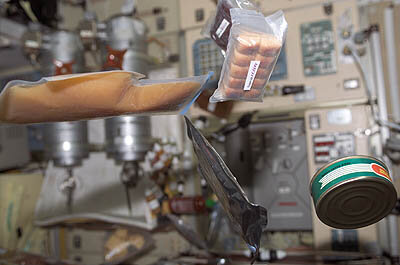
There are several types of food that is eaten in space:
- Rehydratable food: Water is removed to make food easier to store. Also known as freeze-drying. On board, water is replaced in the foods before eaten. Items include beverages (tea, coffee, orange juice) and cereals such as oats.
- Thermo stabilised food: heat processed food which can then be stored at room temperature. Most of the fruits and fish (tuna) are prepared in cans with easy pull tabs. Desserts are packaged in plastic cups.
- Irradiated foods: Most of the beef products are cooked and packaged in flexible foil pouches and sterilized by ionising radiation so they can be kept at room temperature.
- Fresh foods: such as apples and bananas – often fresh supplies are brought up by new crews.
- Natural form foods: such as nuts and cookies.
Astronauts use the trays as plates and everything has to be either squeezed out of a tube or bag. Can you imagine what would happen if the drink and crumbs were allowed to escape and floated wherever they wanted? Look at all the electric equipment around… yes, disaster!
It is very expensive to carry all this mass on to the station so everything has to be very light and easily stored.
Experiment: compare browning or spoiling of ripe fruit with a chemical inhibitor and air
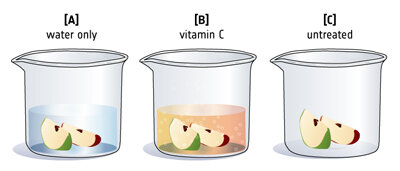
Materials:
Distilled water, apples, bananas, celery sticks and carrots, vitamin C tablets. Small plastic bowl, knife, spoons and paper plates.
Introduction:
When you expose foods such as apples and bananas to air what happens? This browning spoils the food. In space we need to save space and weight of certain fresh foods to avoid waste in peels and cores. The food also has to be packed as one person portions. This can be done by slicing the fruits and vegetable and stopping the air from spoiling them. You are going to see how this can be done with a chemical inhibitor.
Method:
1. In 2 small deep bowls add water. Dissolve one vitamin C tablet in one and leave the other as plain water. Label both bowls accordingly.
2. Cut a piece of fruit into six equal slices. Place 2 wedges into each of the two prepared liquids. Make sure they are immersed completely and leave for 10 minutes.
3. Remove each wedge with a spoon and place in separate paper plates.
4. Place the last 2 wedges on a paper plate marked 'untreated'.
5. Repeat with different fruits and vegetables.
6. Let all 3 plates stand for an hour and observe for any browning.
Discussion:
- Which fruit and which vegetable did not turn as brown as the others?
- Can you think of another chemical inhibitor which can be used to preserve fruits and vegetables and is also edible?
- Try to see if the amount of Vitamin C affects the rate at which vegetables and fruit turn brown. How would you do this?
Answers:
- Those treated with Vitamin C will show less spoiling. This is because Vitamin C acts as an antioxidant and inhibits the action of oxygen on foods (the browning effect).
- Sugar, salting, acids (vinegar)..
- Suggestions: Cut up the Vitamin C tablets into halves and quarters and dissolve in the same amount of water as the whole tablet. See if reducing the dosage has any effect.
Exercise and Fitness
The human body evolved on Earth, in a gravity field. Absence of weight leads to health problems such as bone and muscle loss. Weightlessness also makes it harder to do even small tasks.
The astronauts have to anchor themselves firmly, or they would drift away - even using the computer becomes difficult. Space walks can be exhausting and put unusual strain on muscles. This means that astronauts have to take time to exercise and keep themselves fit and healthy to carry out their job on the ISS and to return to Earth in good shape.
On board there is a treadmill and an exercise bicycle (without tyres!). Astronauts have to do at least 2 hours of exercise per day to keep in good shape.
There are also various pulleys and ropes which are similar to a gym on earth where they can do resistance training all which help maintain the condition of their bones and muscles – also very important as when they return back to gravity on Earth their physical condition is maintained as good as possible.



